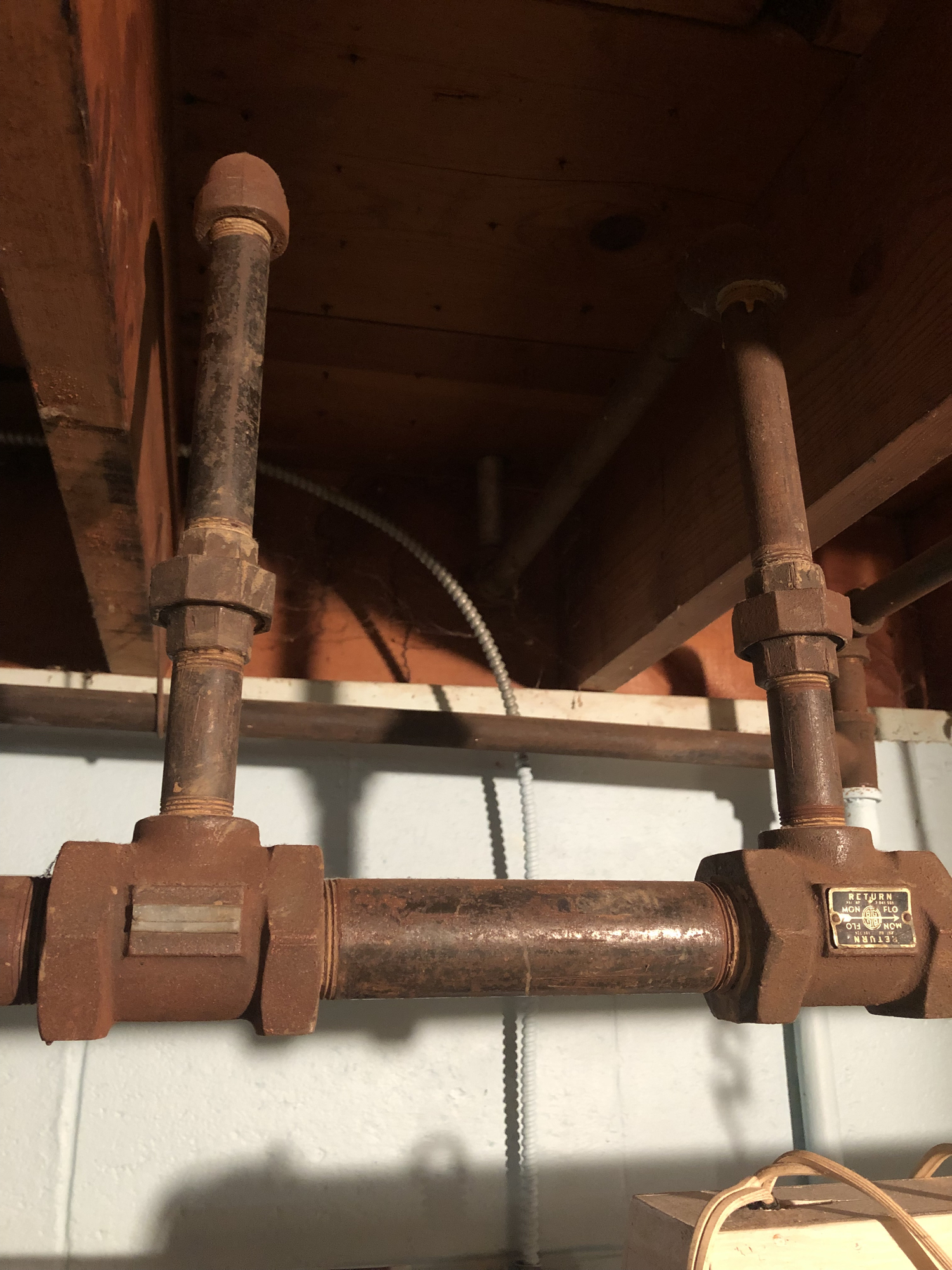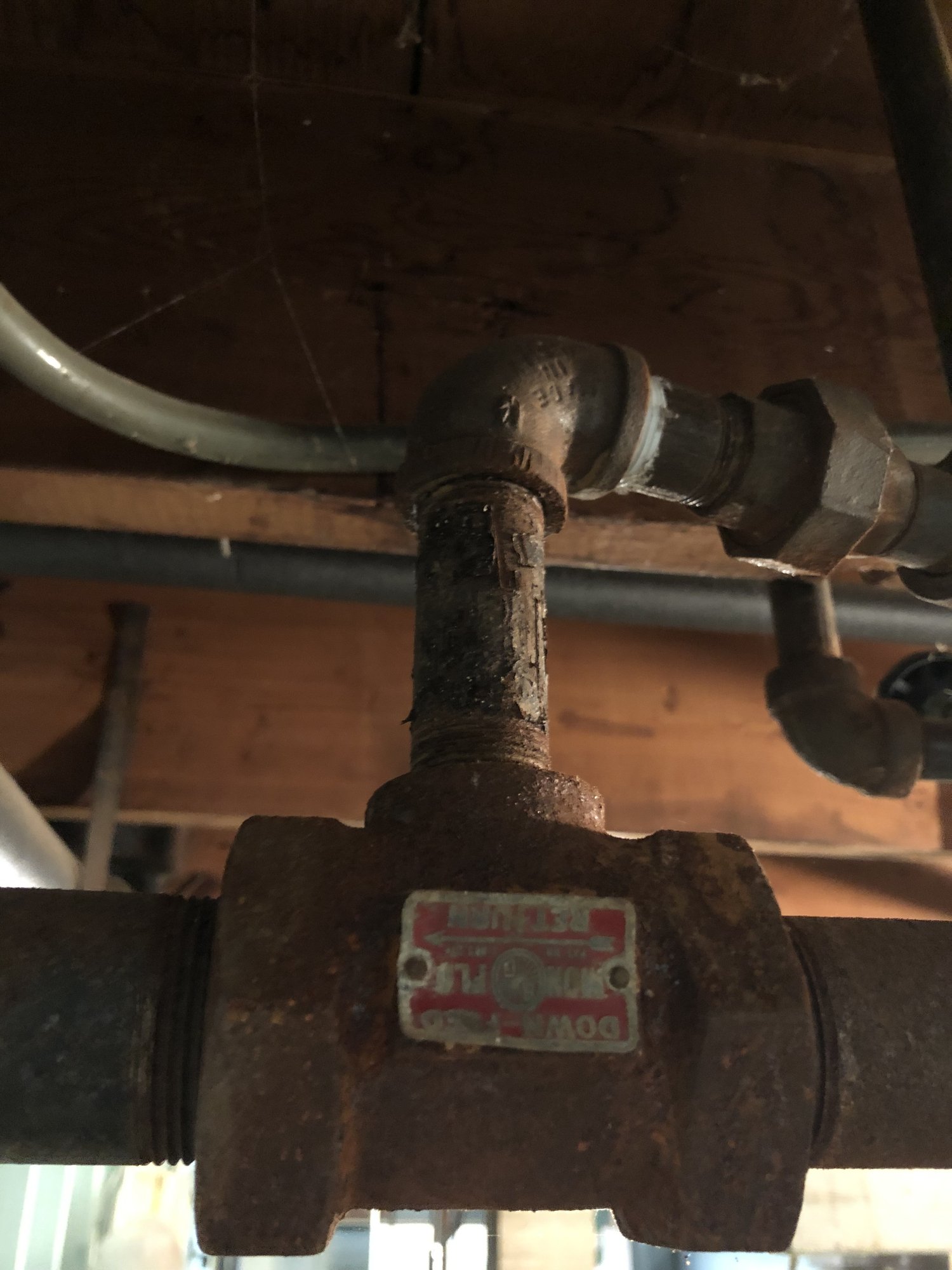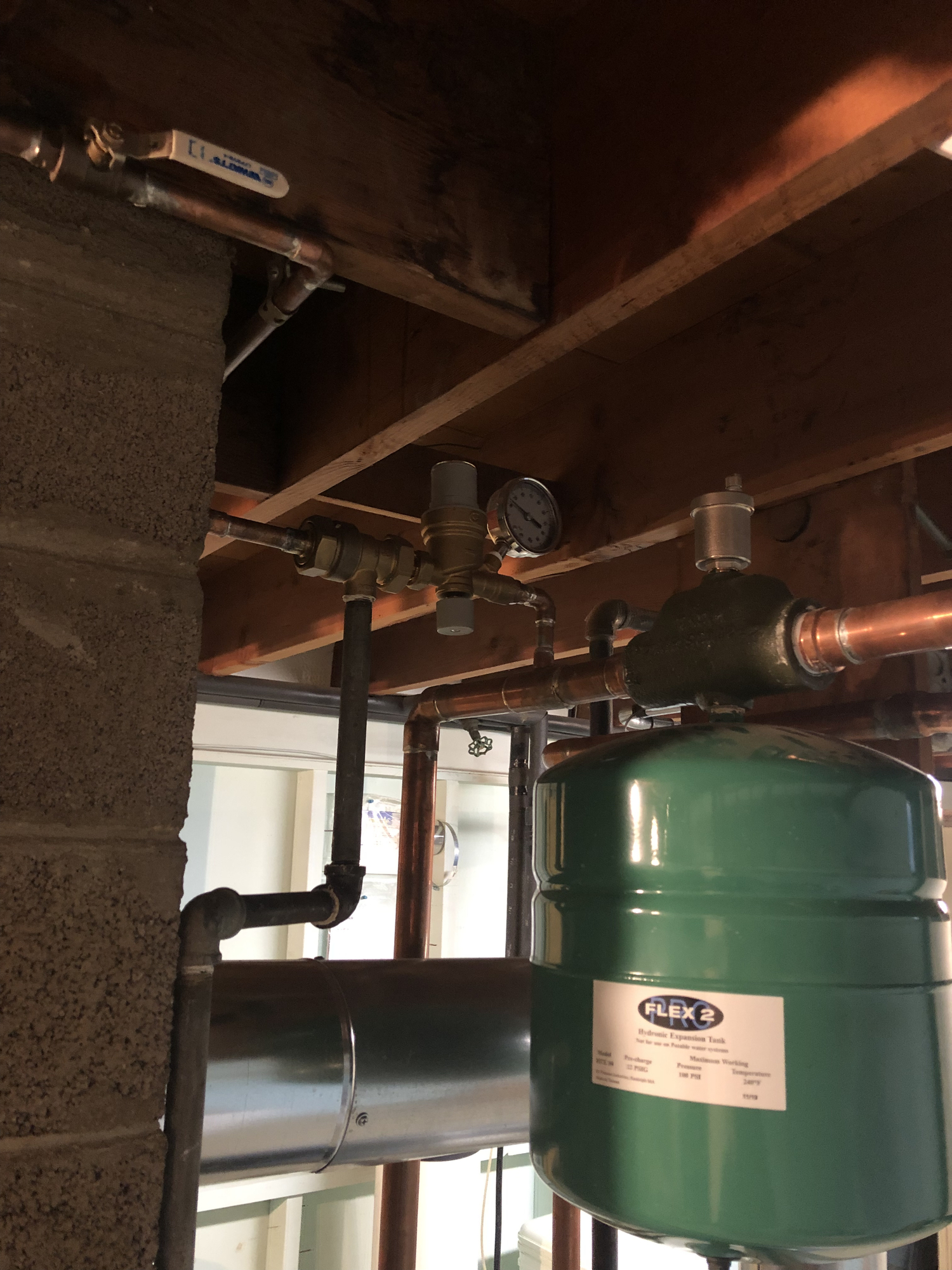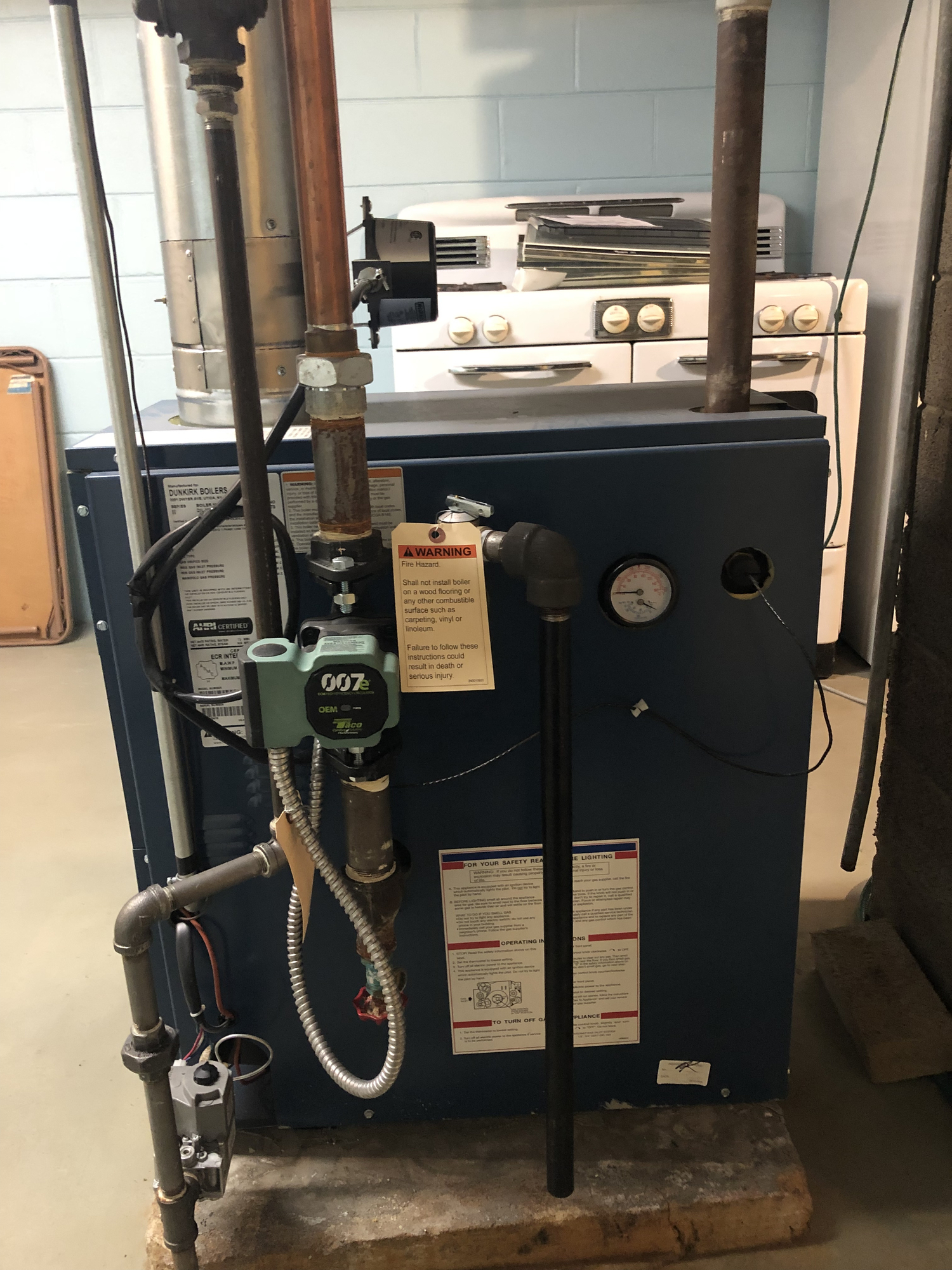Welcome! Here are the website rules, as well as some tips for using this forum.
Need to contact us? Visit https://heatinghelp.com/contact-us/.
Click here to Find a Contractor in your area.
If our community has helped you, please consider making a contribution to support this website. Thanks!
Help with a Monoflow System
Options
Achromia
Member Posts: 5
in Gas Heating
Hi all,
Wanted to start by saying I am a new first-time homeowner at the young age of 26 and this site has been an extreme wealth of information to me in the past few months, so thank you all for your knowledge. I recently bought a Brick Ranch home with a full basement built in 1957, and the home is on a hot water boiler system. The boiler was replaced by the previous owner in 2020, and it is Dunkirk DXL-100 Series 2.
In the past few weeks I have come to understand that the home uses a “one-pipe” or Monoflow system, and I have some questions regarding this kind of system, my personal home layout, and the proper ways to maintain this sort of system. There is not much info available elsewhere to understand the basics of this system (from what I can find) other than bits and pieces on this forum and others.
In the past few weeks I have come to understand that the home uses a “one-pipe” or Monoflow system, and I have some questions regarding this kind of system, my personal home layout, and the proper ways to maintain this sort of system. There is not much info available elsewhere to understand the basics of this system (from what I can find) other than bits and pieces on this forum and others.
First let me say that the home has all original (I assume) cast iron baseboard heating in the living room, kitchen, and 3 bedrooms. I have a full bath and a half bath that are both supplied heat by two recessed CI panel radiators. The heat in the house so far has been great, but the cold season is just now starting.
With that said, I have some questions regarding the layout of my house. I will attach a picture I drew (poorly) of my house layout. My questions are numerous actually but I’ll try to keep the opening somewhat brief and hopefully expand a bit in the next few posts..
First, my boiler is in my basement, the main loop goes around my entire basement in what I believe to be a clockwise motion. For a single level home system with baseboards above the boiler, all literature I see says the main loop should have only one Monoflow tee installed on the return piping from each baseboard/radiator. My system has two on every single supply and return of each BB in my home. Is this proper, or problematic? Does it affect flow on the main loop?
First, my boiler is in my basement, the main loop goes around my entire basement in what I believe to be a clockwise motion. For a single level home system with baseboards above the boiler, all literature I see says the main loop should have only one Monoflow tee installed on the return piping from each baseboard/radiator. My system has two on every single supply and return of each BB in my home. Is this proper, or problematic? Does it affect flow on the main loop?
Second, I have speculation that some of the Monoflow tees are possibly installed in a backwards direction of what I would consider the proper return flow of the loop. Is there a way to determine flow of an original Bell&Gossett tee that does not have the red ring? Some of my tees have stamped tags indicating flow and they are pointing AGAINST flow, but others have been damaged or painted over entirely.
Third and final for now, I have seen diagrams of Monoflow systems that seem very similar to mine, but are pictured with both return and supply loops connected and a separate circulator that continuously flows independent of the boiler when the boiler is not firing. My system is a simple one pipe design where the supply from boiler ends at the return side of boiler. This return side is where my circulator is installed. Does anyone know if this is correct or should the loop be piped in a way to bypass the boiler as stated above?
Third and final for now, I have seen diagrams of Monoflow systems that seem very similar to mine, but are pictured with both return and supply loops connected and a separate circulator that continuously flows independent of the boiler when the boiler is not firing. My system is a simple one pipe design where the supply from boiler ends at the return side of boiler. This return side is where my circulator is installed. Does anyone know if this is correct or should the loop be piped in a way to bypass the boiler as stated above?
Sorry for an extremely long first post, and probably for incorrect terminology and explanation! If anybody has any knowledge about these particular systems I would love to learn some more about them, they seem to be a dying art in a way! Thanks in advance for any answers. 













0
Comments
-
You may want ook at the this booklet about about Hydronic Heating. Even though it is called "Zoning Made Easy", there are some basic information topics that apply to your system.
http://media.blueridgecompany.com/documents/ZoningMadeEasy.pdf
Look on page 22 for the details on the way your system operatesEdward Young Retired
After you make that expensive repair and you still have the same problem, What will you check next?
2 -
Thank you, Ed! That’s a great resource and has great visuals to understand a Monoflow design.On that topic, as that booklet illustrates on the monoflow page, it shows only the diverter tee installed on the return piping coming from the heat emitters. My particular system has what appears to be tees on both the supply branch piping into the baseboard, and on the return. I assume since I receive good heat from all baseboards that this isn’t a problem?0
-
I think its safe to say after 64 years, the guys who piped your system did it right.
What you saw with 2 circulators sounds like primary/secondary.
I'm not crazy about the double bushings at the gas cock.
How is the condition of the bleeders on the convectors? If a branch loop gets air bound, vents with 16 coats of paint on them isn't good for anyone. Looking again, I don't see a purge station on the return, making those bleed valves more important.
0 -
Welcome. You have the same system that was in my house. The resistance created by the monoflow tee is different depending on the orientation (forward or backwards). The guys that installed your system may have very well allowed for that depending on the length of baseboard.
You have a very simple system, and as long as it is working well I would sleep easy. If you do ever open it up for some reason, I would consider moving the circulator so it pumps away from the expansion tank...but I would not go into the system just for that.0 -
Thanks for the reply! In an effort to learn something for myself at the start of the heating season I did open all bleeders on both the cast iron radiators and the recessed convectors (is that the proper terminology for those types of radiators?)
The baseboards and convectors have coin style bleeders which, as you correctly estimated, have been painted quite a few times. They do all open and close enough to bleed though. When I tried bleeding them I got no air, only a steady stream of water. I assume this is good but I have been reading that Monoflow designs are notoriously difficult to bleed properly? If it helps there is a Taco Air Scoop and Air Vent installed above my expansion tank, I would guess that having those installed helps somewhat?Not sure what you mean about the gas cock, what is wrong in that setup? HVAC is not my trade and unfortunately I have a lot to learn as a homeowner. Thanks!0 -
@Achromia
Many systems use two monoflow tees. It all depends on the flow resistance of the system. I would not give that a second thought.....especially since it works well.
I lived with a 1955 monoflow system in my old house for 35 years and they get badmouthed a lot for no reason. They work fine if everything was designed and installed right and yours seems fine.
There is only one issue with a monoflow system if it needs to be drained for service it can be difficult to get the air out of the system.0 -
Thank you all for easing my mind a bit. The system does indeed work really well. I think perhaps the boiler is a bit oversized for my home, but I delved through tons of posts and manuals for my boiler in an effort to help with the efficiency.I realize this is a bit off topic and will post it somewhere separately if I need to but the boiler is set up as a cold start currently, and has a built in “thermal targeting” aquastat that works similarly I guess to an outdoor reset. Right now, on a call for heat from my thermostat, the boiler will fire from “cold” (65-70 degrees) to a target temp of 145 in about 28 minutes. By the time the boiler reaches roughly 135 degrees, my thermostat’s call for heat has been satisfied and the burners shut off.My concern is with condensation, seeing as currently my boiler temps do not truly get above 130. There is an onboard control on this boiler which does not operate my circulator until a boiler temp of 125 is reached, and then shuts the circulator back off when boiler temp drops to 115. Is this enough to protect from condensation in a cold start system? Sorry for the total off topic!0
-
The answer to the flue gas condensation is going to be a little bit murky. On a cold start does the pump cycle on and off before staying on?
If the boiler temp is getting up in 28 min I think your fine. You wouldn't have "sustained flue gas condensation"
I would look around the flue pipe and in the boiler passages for any rust,calcium etc. Deterioration of the flue pipe is one of the first signs.
I would probably raise the low limit for the pump to at least 130-120 for now.
And it depends how often it happens. Most likely this is a spring and fall thing and during the winter when it cycles more it's probably fine.
deterioration isn't usually very fast, it's like eating the wrong food now and having a heart attack in 10 years.
If you think it's a problem down the road a three way valve at the boiler is the fix0 -
 The gas shut off valve. I don't know if those bushings are to code.
The gas shut off valve. I don't know if those bushings are to code.
Are you able to adjust the temperature the circulator can start?0 -
Installers usually use one Monoflow tee when the radiator is above the piping and two Monoflow tees when below. Two are needed for the latter because heated water is buoyant and needs more help to get it to move down. They may have used two because of this situation:

Ideally, the pair of tees are as far apart from each other as the length of the radiator, otherwise the water is less likely to flow through the branch. There is a greater pressure drop through the branch.
@EBEBRATT-Ed said:There is only one issue with a monoflow system if it needs to be drained for service it can be difficult to get the air out of the system.This can't be stressed enough. It can be a real problem.8.33 lbs./gal. x 60 min./hr. x 20°ΔT = 10,000 BTU's/hour
Two btu per sq ft for degree difference for a slab0 -
A 3-way mixing valve? I haven’t read much about them but understand that they mix warmer supply water with colder return to increase return temps, correct? Is this easy/applicable on a monoflow design or would it cause loop problems?EBEBRATT-Ed said:The answer to the flue gas condensation is going to be a little bit murky. If you think it's a problem down the road a three way valve at the boiler is the fixHVACNUT said:
I am not sure if they are code but I’m glad that you brought it up. I measured my NG inlet pipe at 1 1/4” and the piping into my boiler is reduced through those bushings down to 3/4”. The home is an unincorporated portion of my city, I don’t suppose that makes any difference? If there is a better way of reducing inlet size I will try to find out! In regards to the circulator I am not physically able to adjust the temperature which the Taco 007E circ turns on, at least that I know of. This boiler has a setting to run circulator at 125 temp and then shut it back off at 115 temp once colder water reaches boiler return side. This cycle continues about 5 or 6 times with water heating up, circ running, cold water reaching boiler and temps dropping to 115 and circ shuts off. It takes a while for return water to finally even out above 125 degrees. The gas shut off valve. I don't know if those bushings are to code.
The gas shut off valve. I don't know if those bushings are to code.
Are you able to adjust the temperature the circulator can start?Installers usually use one Monoflow tee when the radiator is above the piping and two Monoflow tees when below. Two are needed for the latter because heated water is buoyant and needs more help to get it to move down. They may have used two because of this situation: Ideally, the pair of tees are as far apart from each other as the length of the radiator, otherwise the water is less likely to flow through the branch. There is a greater pressure drop through the branch.
@EBEBRATT-Ed said: There is only one issue with a monoflow system if it needs to be drained for service it can be difficult to get the air out of the system.This can't be stressed enough. It can be a real problem.Thanks for the information, Alan! I thought it was strange that those tees were so closely spaced on my loop considering I have a large run of connected BB in my living room. The supply and return seemed way closer together than I would have expected so your info makes a lot more sense. In regards to air, do any of you know or have any literature regarding the proper way to bleed air from MF systems? I have seen a lot of differing info: boiler hot circ on, boiler cold no circ, clockwise, counterclockwise… etc haha.Thanks to you all! Happy Early Thanksgiving to you and your families!0
Ideally, the pair of tees are as far apart from each other as the length of the radiator, otherwise the water is less likely to flow through the branch. There is a greater pressure drop through the branch.
@EBEBRATT-Ed said: There is only one issue with a monoflow system if it needs to be drained for service it can be difficult to get the air out of the system.This can't be stressed enough. It can be a real problem.Thanks for the information, Alan! I thought it was strange that those tees were so closely spaced on my loop considering I have a large run of connected BB in my living room. The supply and return seemed way closer together than I would have expected so your info makes a lot more sense. In regards to air, do any of you know or have any literature regarding the proper way to bleed air from MF systems? I have seen a lot of differing info: boiler hot circ on, boiler cold no circ, clockwise, counterclockwise… etc haha.Thanks to you all! Happy Early Thanksgiving to you and your families!0 -
The double bushing on gas line aren’t great but aren’t worth messing with unless you get back into the systems at some point. At which time you should move the circulator to the other side of the pressure tank (aka point of no pressure change) as @Robert_25 mentioned earlier in the thread.If you decide to put a mixing valve in that would be a good time to update the circulator position.0
Categories
- All Categories
- 87.3K THE MAIN WALL
- 3.2K A-C, Heat Pumps & Refrigeration
- 61 Biomass
- 427 Carbon Monoxide Awareness
- 119 Chimneys & Flues
- 2.1K Domestic Hot Water
- 5.8K Gas Heating
- 114 Geothermal
- 165 Indoor-Air Quality
- 3.7K Oil Heating
- 76 Pipe Deterioration
- 1K Plumbing
- 6.5K Radiant Heating
- 395 Solar
- 15.6K Strictly Steam
- 3.4K Thermostats and Controls
- 56 Water Quality
- 51 Industry Classes
- 50 Job Opportunities
- 18 Recall Announcements




